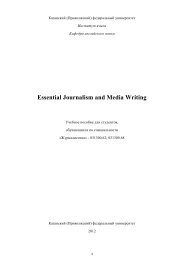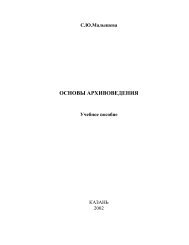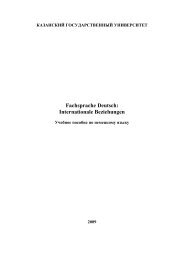Create successful ePaper yourself
Turn your PDF publications into a flip-book with our unique Google optimized e-Paper software.
8<br />
Sarmatians or the Savromatians. Analysis of their tribal ethnic names shows<br />
that they were all Turkic-speaking; indeed the <strong>works</strong> of numerous<br />
contemporary scholars and specialists demonstrate convincingly that the<br />
Scythians were a Turkic people, and this is directly confirmed by the<br />
documentary evidence in Western European written records from the Middle<br />
Ages. Moreover, the Scythians were anthropologically speaking<br />
predominantly of the Europid type. <strong>The</strong> primeval habitat of the Scythian<br />
tribes in Europe, including Huns, Avars, Bulgars and others, was the Middle<br />
Volga Region and the Kama River Basin, where they appeared probably no<br />
later than the third millenium BC. Some of these tribes subsequently settled in<br />
the wide expanse of land between the Volga and the Don, an area they began<br />
to call Asia. At some point, evidently around the end of the third millenium<br />
BC, tribes from the Middle Volga Region migrated to Central, Southern and<br />
Northern Europe, passing as they went through the Upper Volga and the lands<br />
surrounding the Baltic Sea. * In all probability these tribes were the<br />
progenitors and guardians of the so-called Battle-Axe Culture. † At a later date<br />
these Turkic-speaking peoples from the Middle Volga and Kama Basin<br />
Regions began also to migrate, via the Sea of Azov and Black Sea regions, to<br />
Southern, Central and Northern Europe. In this way, since earliest antiquity<br />
the dominant peoples of Europe stemmed from Turkic-speaking tribes.<br />
Taking all factors into consideration, it seems likely that the greater part<br />
of the European territory into which the Turkic-speaking peoples migrated<br />
would have been inhabited by aboriginal populations speaking autochthonous<br />
languages which were inflected. Clues, albeit extremely rare and meagre, that<br />
these lands were indeed inhabited by such tribes and peoples are occasionally<br />
to be found in the written records of ancient writers. <strong>The</strong> theory that the<br />
languages spoken by such folk would have been inflected, or fusional, rests<br />
on the following propositions.<br />
As has already been pointed out, the only written sources to have been<br />
discovered in Europe dating back to antiquity are in Greek and Latin even<br />
though, based on ethnonyms, onomastic and other linguistic studies a<br />
significant proportion of the population at this time must have been Turkicspeaking.<br />
But from the 10 th to 12 th Centuries AD onwards written sources<br />
start to appear in a variety of inflected tongues which form the basis for all<br />
languages spoken throughout Europe today. To be precise, no traces have<br />
come down to us today of any inflected language before the 10 th to 12 th<br />
centuries. Moreover, at a slightly earlier time than this, sources in Ancient<br />
Greek disappear from the record, followed after a short while by Latin. Later<br />
still Turkic onomastics and terms vanish from the Latin sources: all that<br />
* In Russian, the term ‘Pribaltika’ usually refers today to the three Baltic States of Lithuanian, Latvia and<br />
Estonia. However, in the broader topographical and ethnographical senses it may also refer to all those lands<br />
having access to the Baltic Sea, thus also Denmark, Finland, Germany, Iceland, Norway, Poland, North West<br />
Russia itself and Sweden<br />
† Also known as Corded Ware Culture and Single Grave Culture, names reflecting different aspects in the<br />
archeological record of its artefacts and burial customs.





